Easy Wild Garlic Mustard Pesto

Garlic mustard pesto is a great beginner recipe for new foragers and one of the early spring plant species that starts the foraging season in my area. Unfortunately, garlic mustard isn't going away anytime soon. It's one of the most invasive weeds in North America and has been identified as a weed in almost every state.
However, this bitter herb has gained popularity as an herb and condiment because of its distinct taste caused by glucosinalin, which some have compared to horseradish.
This post shares a bit about this invasive but delicious invasive plant, where to find it, and how to use it!
Garlic mustard (Alliaria petiolata), also known as jack-by-the-hedge, hedge garlic, sauce alone, garlic root, garlic work, and mustard root, is a biennial flowering plant in the mustard family (Brassicaceae).
It is native to Europe, western and central Asia, and northwestern Africa, from Morocco and Iberia east to western Siberia. Still, it is considered an invasive species in many locations outside its native range.
Garlic mustard grows throughout the United States, Canada, and Europe. It's a common plant that's pretty easy to find, particularly in wooded areas. However, if you live somewhere the plant is rampant, you can head out into your backyard and probably find it there.
A great way to find garlic mustard is simply to follow your nose. Garlic mustard has a distinct garlic-like aroma, which carries on the breeze like perfume. Walk around for a few minutes with your face tilted toward the wind, and you're almost guaranteed to sniff out some garlic mustard. The nose knows!
Once you know what you're looking for, it's easy to identify garlic mustard by its leaves. In springtime, the plant is topped with a cluster of heart-shaped leaves serrated like lettuce.
These leaves grow from a single stalk with purple flowers on top; later in the season, the flowers produce seeds that fall off on their own or are dispersed by the wind.
Once they fall off, they spread and can take root almost anywhere they land — including your garden! Once garlic mustard plants establish themselves in an area, it's tough to eradicate. The whole plant is edible, depending on what time of year you harvest it.
- Chopped and blanched garlic mustard greens
- Extra virgin olive oil
- Toasted Pepitas
- Garlic cloves
- Parmesan cheese
- Kosher salt, to taste
You're probably already familiar with its intense flavor and smell if you love garlic mustard. But, if you haven't tried it before, prepare to be surprised! This plant has a robust and garlic-like taste and smells that give it its name.
You can often find it growing wild in the spring months in your region. Check out this simple recipe that is perfect for this wild herb.
- First, go out and find some garlic mustard. It will be growing anywhere where the ground isn't paved, including parks and your lawn. It's also very easy to spot because of its distinct shape: it has two leaves that look like they're connected at the bottom and then two more leaves above that that are much smaller.
- Once you've found some garlic mustard, collect it in a bag or pot to have plenty of it to work.
Prep your Wild Greens
- Wash it thoroughly. Remove the stems and leaves from the plant, being sure to discard any that are slimy or discolored Blanch the cleaned leaves in boiling water for 2 minutes
- Strain the garlic mustard using a colander (or if you don’t have one, a large sieve or strainer)
- You might want to wear gloves to do this next bit as garlic mustard is known to stain
Make your pesto
- Add your blanched leaves to a food processor, two crushed cloves of garlic, and ½ cup of Parmegiano cheese (or any other hard cheese).
- Blend everything until the mixture is smooth while slowly adding olive oil until you get the consistency you want.
- At this point, feel free to add salt or pepper to taste.
- Congratulations! You just made pesto out of an invasive weed! Now just serve it over pasta or as a spread on toast.
The young leaves of garlic mustard can be eaten raw in salads or used as a cooked vegetable, like spinach or kale. The roots can be washed and eaten raw or boiled like other root vegetables similar to horseradish. They can also be dried and ground into a powder for flavoring soups, sauces, and baked goods. After the plant flowers and then goes to seed. The seed pods are filled with tiny black seeds that allow way to eat the invasive garlic mustard! The seeds have a bold flavor profile and are similar to horseradish.
Please note that raw garlic mustard should be consumed in small quantities as there is a level of arsenic (similar to apple seeds) that may be an issue. This study from NIH on garlic mustard shares the data from this 2007 study.
Some folks believe the best part of the plant is the top flower buds before the plant goes to seed.
We've got you covered if you're in the mood for a new way to eat garlic mustard.
Later in its cycle, harvest the seeds to make your own Dijon Mustard condiment or use them as a flavoring like in these Balsamic Pickled Onions with Wild Mustard Seeds. There are many other ways to eat this invasive wild edible! Here are some great ways to make this delicious plant into a snack:
- Chop up some of the leaves and add them to your salad
- Boil the leaves, then serve them with rice
- Puree the leaves until they're creamy, then use it as a dip or spread
- Garlic mustard tastes great in everything from scrambled eggs to ice cream!
The best time to look for these wild edibles is in mid-spring when the leaves are tender and just starting to unfurl. They have a milder flavor at this stage than during the summer when they get tougher and can be slightly bitter.
The stems are tender at this stage, so don't throw them away when you're making your pesto!
Gather the young leaves from the top of the plants. Don't use flowers or leaves from the bottom of the plant. Flowers are not edible, and older leaves can be tough and bitter.
Cut off any tough stems with a sharp knife, and rinse the leaves under cool water. Shake them dry, or lay them on a towel to absorb moisture.
Place the leaves in a large salad spinner or colander to dry completely. This can take a few hours, so be patient - wet pesto is not very good!
When the leaves are completely dry, they are ready to be used in your favorite recipe.
Garlic mustard (Alliaria petiolata) is a biennial herbaceous flowering plant native to Europe and Asia but made its way to the United States and has spread all across the country.
Wild garlic mustard is a culinary herb used for salads and sauces, as well as being added to many other dishes. It can be found in the wild or you can grow it yourself.
How do you cut garlic mustard?To cut garlic mustard, take a sharp knife and slice the stem off.
Are garlic mustard seeds edible?Garlic mustard seeds are edible.
We've got foraging-related recipes and sign up here to be the first to see what I'm making with wild foods and learn all the delicious ways to find edible plants in your own yard.
Easy Wild Garlic Mustard Pesto
Recipe details
Ingredients
- 1 cup Garlic Mustard leaves, packed (about 2 oz)
- ¼ cup pepitas
- ¼ cup olive oil
- 2 cloves of garlic
- Salt and pepper to taste
- ⅕ oz Parmesan Cheese
Instructions
- To make the pesto, bring a large pot of water to boil. Meanwhile, if you have the choice, pick a few young garlic mustard leaves from the center of the plant, where they are most tender.
- Once your water is boiling, add the garlic mustard and cook for about 30 seconds. Scoop out with a slotted spoon and transfer to a bowl of ice water (this will stop the cooking process). Drain well.
- Combine all ingredients in a food processor and pulse until smooth.
- Add more olive oil as needed to create desired consistency.
- Store in an airtight container in the refrigerator, or freeze in ice cube trays.
Tips
- The first thing to do is make sure you've correctly identified garlic mustard. It has heart-shaped leaves and tiny white flowers.
- Some people confuse it with wild violet or rue, which are edible, or poison hemlock, which is not. Learn to identify the difference before you eat any wild plants.
- The best time to look for wild garlic mustard is in mid-spring when the leaves are tender and just starting to unfurl. They have a milder flavor at this stage than during the summer when they get tougher and can be slightly bitter.
- The stems are tender at this stage as well, so don't throw them away when you're making your pesto!





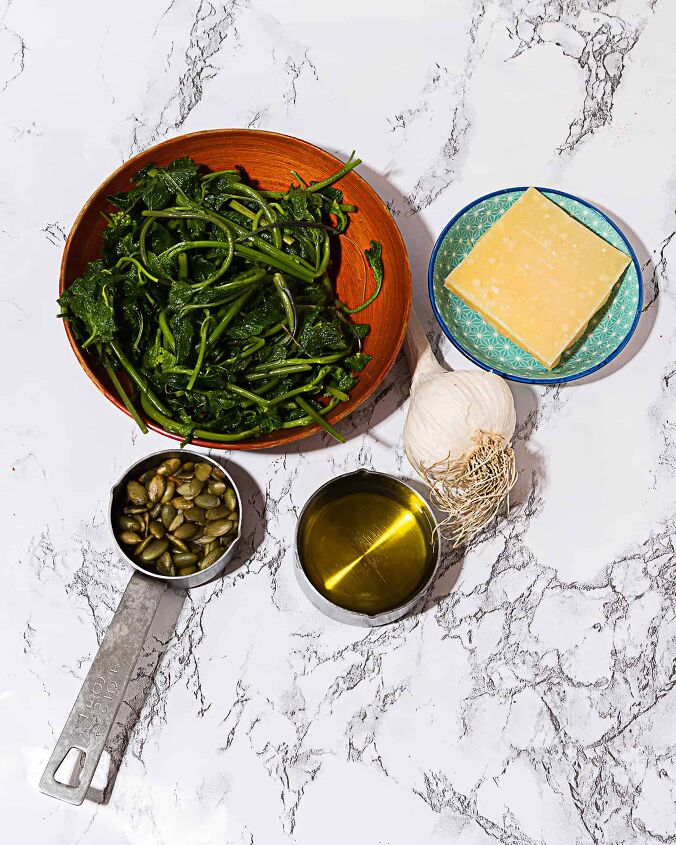






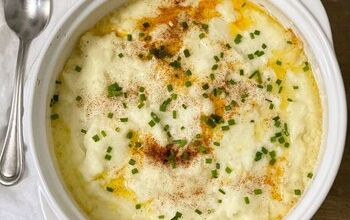




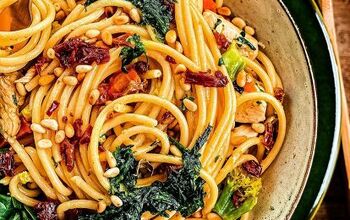
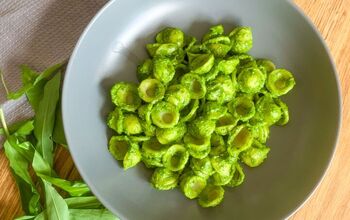
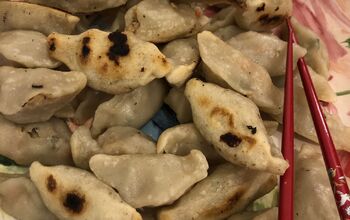






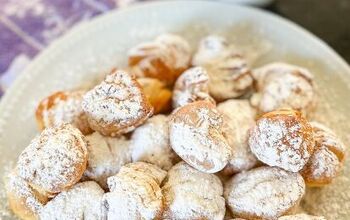



Comments
Share your thoughts, or ask a question!
It would be helpful if there was an actual picture of the actual plant